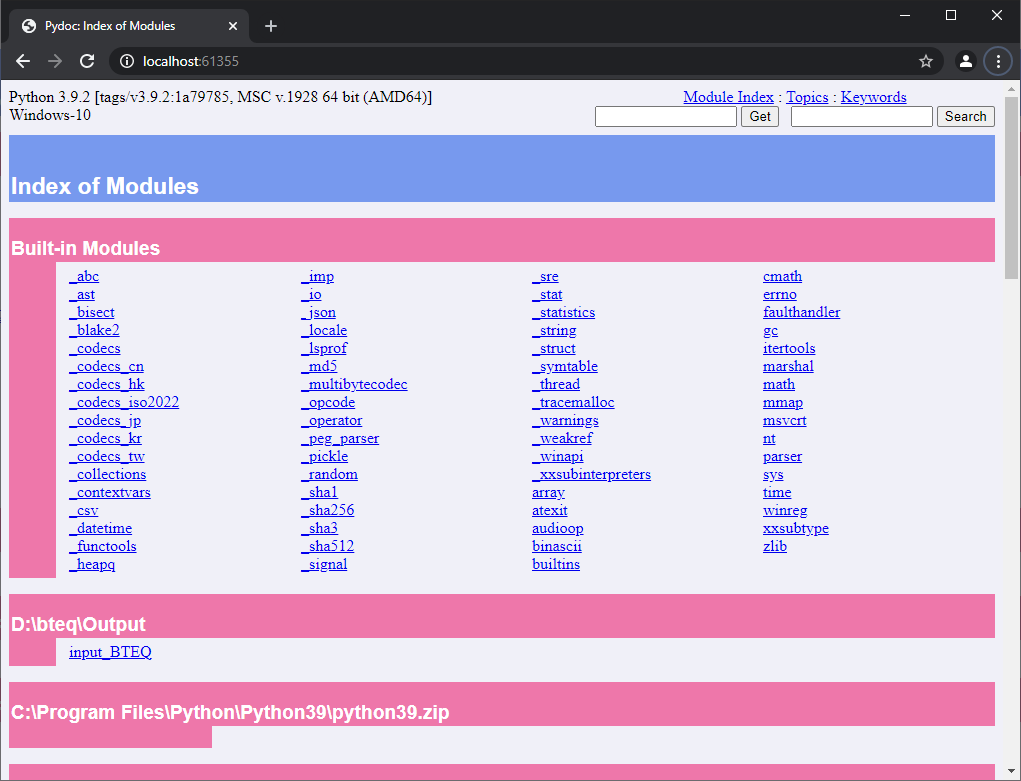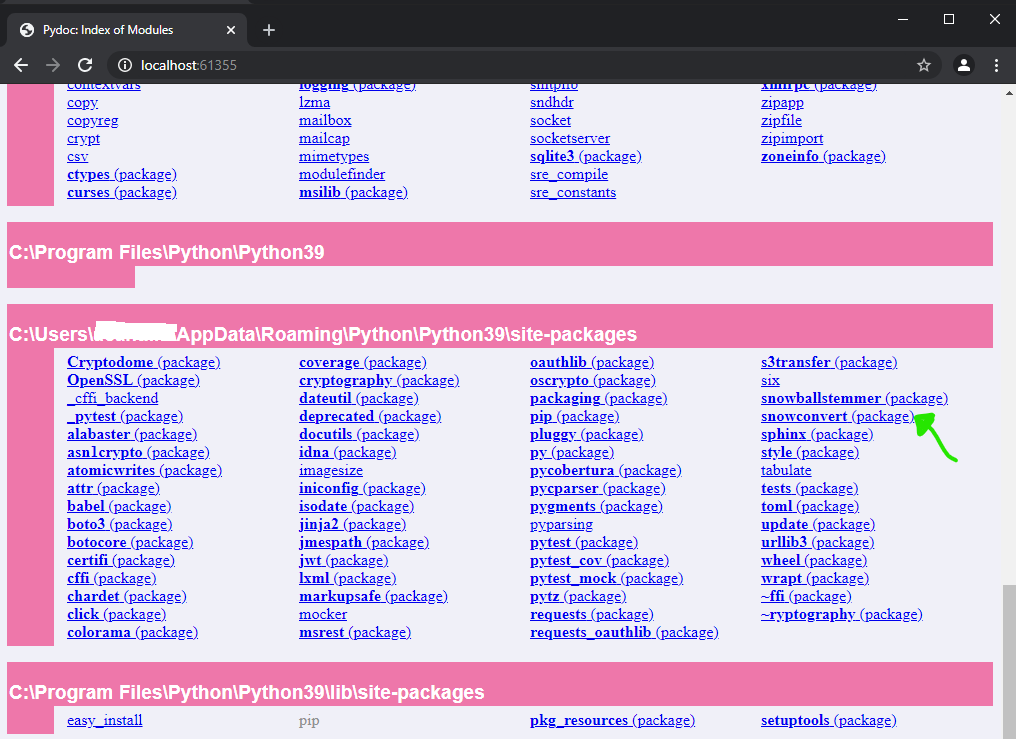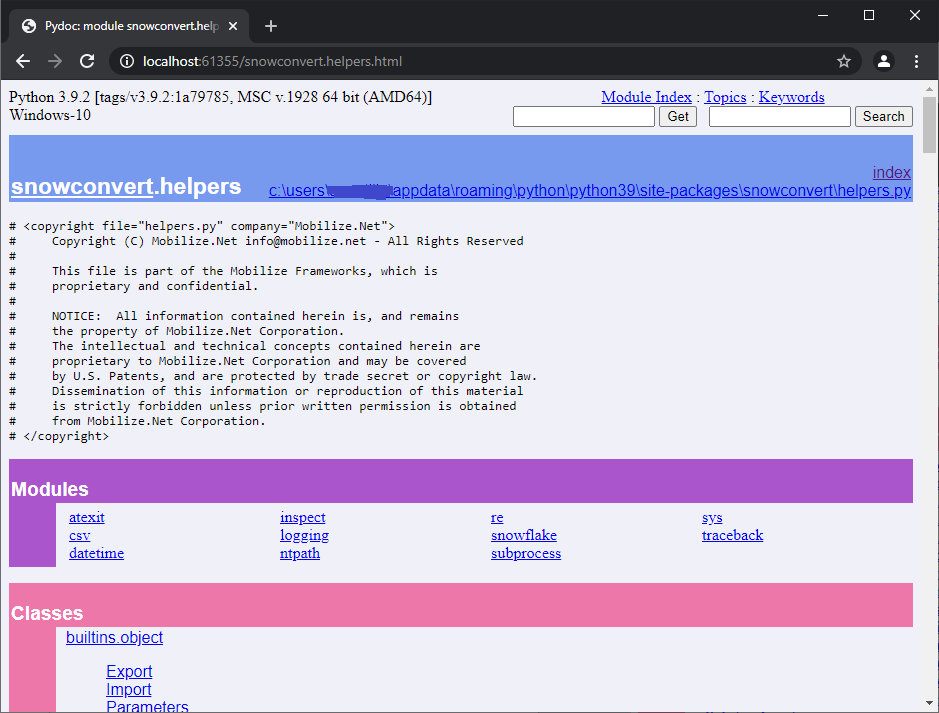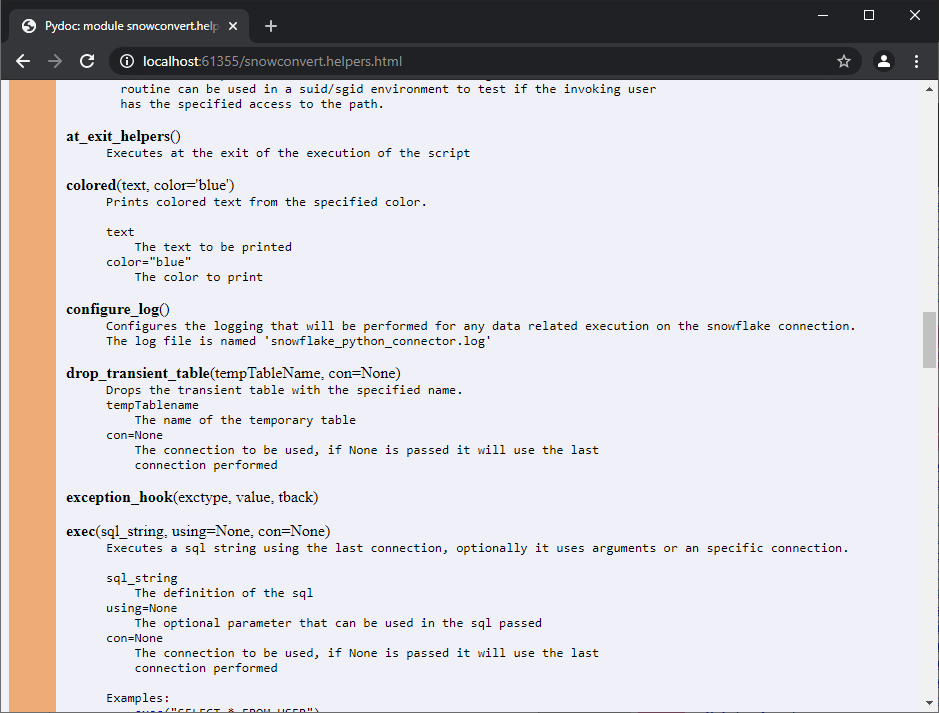SnowConvert AI - Teradata - SnowConvert AI Scripts Helpers¶
SnowConvert AI Helpers is a set of classes with functions designed to facilitate the conversion of Teradata script files to Python files that Snowflake can interpret.
SnowConvert AI for Teradata can take in any Teradata SQL or scripts (BTEQ, FastLoad, MultiLoad, and TPump) and convert them to functionally equivalent Snowflake SQL, JavaScript embedded in Snowflake SQL, and Python. Any output Python code from SnowConvert AI will call functions from these helper classes to complete the conversion and create a functionally equivalent output in Snowflake.
The Snowflake Connector for Python will also be called in order to connect to your Snowflake account and run the output Python code created by SnowConvert.
The latest version information of the package can be found here.
Note
The Python packagesnowconvert-helpers supports Python versions 3.6, 3.7, 3.8, and 3.9.
Script Migration¶
Source¶
Suppose you have the following BTEQ code to be migrated.
insert into table1 values(1, 2);
insert into table1 values(3, 4);
insert into table1 values(5, 6);
Output¶
You should get an output like the one below.
Note
The log_onfunction parameters (‘user’, ‘password’, ‘account’, ‘database’, ‘warehouse’, ‘role’, ‘token’) should be defined by the user.
#*** Generated code is based on the SnowConvert AI Python Helpers version 2.0.6 ***
import os
import sys
import snowconvert.helpers
from snowconvert.helpers import Export
from snowconvert.helpers import exec
from snowconvert.helpers import BeginLoading
con = None
def main():
snowconvert.helpers.configure_log()
con = snowconvert.helpers.log_on()
exec("""
INSERT INTO table1
VALUES (1, 2)
""")
exec("""
INSERT INTO table1
VALUES (3, 4)
""")
exec("""
INSERT INTO table1
VALUES (5, 6)
""")
snowconvert.helpers.quit_application()
if __name__ == "__main__":
main()
Getting Started¶
To install the package, you should run the following command in your python environment. If you’re not familiar with installing packages in Python, visit the following page on python packages (https://packaging.python.org/tutorials/installing-packages/).
pip install snowconvert-helpers
Once your package is installed, you will be able to run the script migrated code in Python.
Run the code¶
To run the migrated code, you just have to open the Command Prompt or the Terminal and execute the following command.
python sample_BTEQ.py
If the script has no errors, you will get in your console an output like the one below.
Executing: INSERT INTO PUBLIC.table1 VALUES (1, 2).
Printing Result Set:
number of rows inserted
1
Executing: INSERT INTO PUBLIC.table1 VALUES (3, 4).
Printing Result Set:
number of rows inserted
1
Executing: INSERT INTO PUBLIC.table1 VALUES (5, 6).
Printing Result Set:
number of rows inserted
1
Error Code 0
Script done >>>>>>>>>>>>>>>>>>>>
Error Code 0
Passing connection parameters¶
There are several ways to pass the connection parameters to the connection of the database:
As parameters in the function call snowconvert.helpers.log_on inside the python file.
As positional parameters with the specific order of user, password, account, database, warehouse, and role when the python is being executed from the command line.
As named parameters with no order restriction of SNOW_USER, SNOW_PASSWORD, SNOW_ACCOUNT, SNOW_DATABASE, SNOW_WAREHOUSE, SNOW_ROLE, SNOW_QUERYTAG, SNOWAUTHENTICATOR and SNOWTOKEN when the python is being executed from the command line and any of them are passed like –param-VARNAME=VALUE.
As environment variables named SNOW_USER, SNOW_PASSWORD, SNOW_ACCOUNT, SNOW_DATABASE, SNOW_WAREHOUSE, SNOW_ROLE, SNOW_QUERYTAG, SNOWAUTHENTICATOR and SNOWTOKEN before python execution.
The previous order specified is the way to determine the precedence.
Parameters in the function call¶
They can be set as positional parameters in the function call as follows.
.....
con = snowconvert.helpers.log_on(
'myuser',
'mypassword',
'myaccount',
'mydatabase',
'mywarehouse',
'myrole',
5,
'myauthenticator',
'mytoken')
.....
Or they can be set any of the named parameters in any order in the function call as follows.
.....
con = snowconvert.helpers.log_on(
account:'myaccount',
password:'mypassword',
user:'myuser',
warehouse:'mywarehouse',
login_timeout:5,
authenticator:'myauthenticator',
toke:'mytoken')
.....
Positional parameters¶
They need to be set in the specific order in the command line as follows.
python sample_BTEQ.py myuser mypassword myaccount mydatabase mywarehouse myrole myauthenticator mytokenr
Or they can be set only some of the parameters but always starting with the user parameter as follows.
python sample_BTEQ.py myuser mypassword myaccount
Named parameters¶
They can be set any of the named parameters in any order in the command line as follows (use a single line, multiline shown for readability reasons).
python sample_BTEQ.py --param-SNOW_WAREHOUSE=mywarehouse
--param-SNOW_ROLE=myrole
--param-SNOW_PASSWORD=mypassword
--param-SNOW_USER=myuser
--param-SNOW_QUERYTAG=mytag
--param-SNOW_ACCOUNT=myaccount
--param-SNOW_DATABASE=mydatabase
--param-SNOW_AUTHENTICATOR=myauthenticator
--param-SNOW_TOKEN=mytoken
--param-PRIVATE_KEY_PATH=myprivatekey
--param-PRIVATE_KEY_PASSWORD=myprivatekeypassword
Environment variables¶
Before calling the python script, any of the following environment variables can be set:
SNOW_USER
SNOW_PASSWORD
SNOW_ACCOUNT
SNOW_DATABASE
SNOW_WAREHOUSE
SNOW_ROLE
SNOW_QUERYTAG
SNOW_AUTHENTICATOR
SNOW_TOKEN
PRIVATE_KEY_PATH
PRIVATE_KEY_PASSWORD
Key Pair Authentication¶
The log_on function can also support the key pair authetication process. Review the following Snowflake documentation for more information about the key creation . Please notice the required parameters:
log_on(
user='YOUR_USER',
account='YOUR_ACCOUNT',
role = 'YOUR_ROLE',
warehouse = 'YOUR_WAREHOUSE',
database = 'YOUR_DATABASE',
private_key_path='/YOUR_PATH/rsa_key.p8',
private_key_password='YOUR_PASSWORD')
Example of passing environment variables¶
Here is an example of using SNOW_AUTHENTICATOR, SNOW_USER and SNOW_PASSWORD. They must be defined before running the output python file and then run the python generated file.
Windows¶
SET SNOW_AUTHENTICATOR=VALUE
SET SNOW_USER=myuser
SET SNOW_PASSWORD=mypassword
python sample_BTEQ.py
Linux/Mac¶
export SNOW_AUTHENTICATOR=VALUE
export SNOW_USER=myuser
export SNOW_PASSWORD=mypassword
python3 sample_BTEQ.py
Enabling Logging¶
To enable logging, you should enable an environment variable called SNOW_LOGGING set as true.
Then, if you want to customize the logging configuration you can pass a parameter to the snowconvert.helpers.configure_log() method like this:
snowconvert.helpers.configure_log("SOMEPATH.conf")
The configuration file should contain the next structure. For more information about python logging, click here
[loggers]
keys=root
[handlers]
keys=consoleHandler
[formatters]
keys=simpleFormatter
[logger_root]
level=DEBUG
handlers=consoleHandler
[logger_simpleExample]
level=DEBUG
handlers=consoleHandler
qualname=simpleExample
propagate=0
[handler_consoleHandler]
class=FileHandler
level=DEBUG
formatter=simpleFormatter
args=('python2.log', 'w')
[formatter_simpleFormatter]
format=%(asctime)s -%(levelname)s - %(message)s
Snowflake¶
Once any migrated code you have been executed, you can go to Snowflake and check your changes or deployments.
select * from PUBLIC.table1;
You will be able to see the rows you have inserted in the example above.

Local Helpers Documentation¶
First of all, it is required to install the python package named pydoc (Available since version 2.0.2 of snowconvert-helpers).
pip install pydoc
Then in order to display the python documentation of the package snowconvert-helpers, you should go to a folder where you have the converted output code and you have a python output.
D:\bteq\Output>dir
Volume in drive D is Storage
Volume Serial Number is 203C-168C
Directory of D:\bteq\Output
05/25/2021 03:55 PM <DIR> .
05/25/2021 03:55 PM <DIR> ..
05/25/2021 03:55 PM 630 input_BTEQ.py
1 File(s) 630 bytes
2 Dir(s) 1,510,686,502,912 bytes free
Located in this directory you need to run:
python -m pydoc -b
The console will open your preferred browser with the HTML help of the documentation for all the installed packages.
D:\bteq\Output>python -m pydoc -b
Server ready at http://localhost:61355/
Server commands: [b]rowser, [q]uit
server>
This will open the browser with the documentation of your code like:

Scroll thru the end of the page to see the installed packages. And you will see something similar to:

Clicking in the SnowConvert AI(package) you will see something like:

Clicking in the module helpers will display a screen similar to:

Then you can scroll thru the functions and classes of the module.

Known Issues ¶
No issues were found.
Technical Documentation¶
Functions¶
All the functions defined in the project.
access¶
Note
access(path, mode, *, dir_fd=None, effective_ids=False, follow_symlinks=True)
Description:¶
Use the real uid/gid to test for access to a path.
dir_fd, effective_ids, and follow_symlinks may not be implemented on your platform. If they are unavailable, using them will raise a NotImplementedError.
Note that most operations will use the effective uid/gid, therefore this routine can be used in a suid/sgid environment to test if the invoking user has the specified access to the path.
Parameters:¶
path,Path to be tested; can be string, bytes, or a path-like objectmode,Operating-system mode bitfield. Can be F_OK to test existence, or the inclusive-OR of R_OK, W_OK, and X_OKdir_fd,If not None, it should be a file descriptor open to a directory, and path should be relative; path will then be relative to that directoryeffective_ids,If True, access will use the effective uid/gid instead of the real uid/gidfollow_symlinks,If False, and the last element of the path is a symbolic link, access will examine the symbolic link itself instead of the file the link points to
at_exit_helpers¶
Note
at_exit_helpers()
Description:¶
Executes at the exit of the execution of the script.
colored¶
Note
colored(text, color='blue')
Description:¶
Prints colored text from the specified color.
Parameters:¶
text,The text to be printedcolor="blue",The color to print
configure_log¶
Note
configure_log(configuration_path)
Description:¶
Configures the logging that will be performed for any data-related execution on the snowflake connection. The log file is named ‘snowflake_python_connector.log’ by default.
Parameters:
configuration_path,The configuration path of the file that contains all the settings desired for the logging
drop_transient_table¶
Note
drop_transient_table(tempTableName, con=None)
Description:¶
Drops the transient table with the specified name.
Parameters:
tempTableName,The name of the temporary tablecon=None,The connection to be used, if None is passed it will use the last connection performed
exception_hook¶
Note
exception_hook(exctype, value, tback)
Description:¶
Parameters:
exctypevaluetback
exec¶
Note
exec(sql_string, using=None, con=None)
Description:¶
Executes a sql string using the last connection, optionally it uses arguments or an specific connection. Examples:
exec("SELECT * FROM USER")exec("SELECT * FROM USER", con)exec("SELECT * FROM CUSTOMER WHERE CUSTOMERID= %S", customer)
Parameters:
sql_string,The definition of the sqlusing=None,The optional parameter that can be used in the sql passedcon=None,The connection to be used, if None is passed it will use the last connection performed
exec_file¶
Note
exec_file(filename, con=None)
Description:¶
Reads the content of a file and executes the sql statements contained with the specified connection.
Parameters:
filename,The filename to be read and executedcon=None,The connection to be used, if None is passed it will use the last connection performed
exec_os¶
Note
exec_os(command)
Description:¶
Executes a command in the operative system.
exec_sql_statement¶
Note
exec_sql_statement(sql_string, con, using=None)
Description:¶
Executes a sql statement in the connection passed, with the optional arguments.
Parameters:
sql_string,The sql containing the string to be executedcon,The connection to be usedusing,The optional parameters to be used in the sql execution
expands_using_params¶
Note
expands_using_params(statement, params)
Description:¶
Expands the statement passed with the parameters.
Parameters:
statement,The sql containing the string to be executedparams,The parameters of the sql statement
expandvar¶
Note
expandvar(str)
Description:¶
Expands the variable from the string passed.
Parameters:
str,The string to be expanded with the variables
expandvars¶
Note
expandvars(path, params, skip_escaped=False)
Description:¶
Expand environment variables of form $var and ${var}. If parameter ‘skip_escaped’ is True, all escaped variable references (i.e. preceded by backslashes) are skipped. Unknown variables are set to ‘default’. If ‘default’ is None, they are left unchanged.
Parameters:
path,params,skip_escaped=False,
fast_load¶
Note
fast_load(target_schema, filepath, stagename, target_table_name, con=None)
Description:¶
Executes the fast load with the passed parameters target_schema, filepath, stagename and target_table_name.
Parameters:
target_schema,The name of the schema to be used in the fast loadfilepath,The filename path to be loaded in the tabletarget_table_name,The name of the table that will have the data loadedcon=None,The connection to be used, if None is passed it will use the last connection performed
file_exists_and_readable¶
Note
file_exists_and_readable(filename)
Description:¶
Parameters:
filename,
get_argkey¶
Note
get_argkey(astr)
Description:¶
Gets the argument key value from the passed string. It must start with the string ‘–param-’
Parameters:
astr,The argument string to be used. The string should have a value similar to –param-column=32 and the returned string will be ‘32
get_error_position¶
Note
get_error_position()
Description:¶
Gets the error position from the file using the information of the stack of the produced error.
get_from_vars_or_args_or_environment¶
Note
get_from_vars_or_args_or_environment(arg_pos, variable_name, vars, args)
Description:¶
Gets the argument from the position specified or gets the value from the table vars or gets the environment variable name passed.
Parameters:
arg_pos,The argument position to be used from the arguments parametervariable_name,The name of the variable to be obtainedvars,The hash with the variables names and valuesargs,The arguments array parameter
import_data_to_temptable¶
Note
import_data_to_temptable(tempTableName, inputDataPlaceholder, con)
Description:¶
Imports data to a temporary table using an input data place holder.
Parameters:
tempTableName,The temporary table name.inputDataPlaceholder,The input place holder used that is a stage in the snowflake databasecon,The connection to be used
import_file¶
Note
import_file(filename, separator=' ')
Description:¶
Imports the passed filename with the optional separator.
Parameters:
filename,The filename path to be importedseparator=' ',The optional separator
import_file_to_temptable¶
Note
import_file_to_temptable(filename, tempTableName, columnDefinition)
Description:¶
Imports the file passed to a temporary table. It will use a public stage named as the temporary table with the prefix Stage_. At the end of the loading to the temporary table, it will delete the stage that was used in the process.
Parameters:
filename,The name of the file to be readtempTableName,The name of the temporary tablecolumnDefinition,The definition of all the fields that will have the temporary table
import_reset¶
Note
import_reset()
Description:¶
log¶
Note
log(*msg, level=20, writter=None)
Description:¶
Prints a message to the console (standard output) or to the log file, depending on if logging is enabled
Parameters:
*msg,The message to print or loglevel=20,writter=None,
log_on¶
Note
log_on(user=None, password=None, account=None, database=None, warehouse=None, role=None, login_timeout=10, authenticator=None)
Description:¶
Logs on the snowflake database with the credentials, database, warehouse, role, login_timeout and authenticator passed parameters.
Parameters:
user,The user of the databasepasswordThe password of the user of the databasedatabase,The database to be connectedwarehouse,The warehouse of the database to be connectedrole,The role to be connectedlogin_timeout,The maximum timeout before giving error if the connection is taking too long to connectauthenticator,The authenticator supported value to use like SNOWFLAKE, EXTERNALBROWSER, SNOWFLAKE_JWT or OAUTHtoken,The OAUTH or JWT token
os¶
Note
os(args)
Description:¶
Parameters:
args,
print_table¶
Note
print_table(dictionary)
Description:¶
Prints the dictionary without exposing user and password values.
Parameters:
dictionary,
quit_application¶
Note
quit_application(code=None)
Description:¶
Quits the application and optionally returns the passed code.
Parameters:
code=None,The code to be returned after it quits
read_params_args¶
Note
read_param_args(args)
Description:¶
Reads the parameter arguments from the passed array.
Parameters:
args,The arguments to be used
readrun¶
Note
readrun(line, skip=0)
Description:¶
Reads the given filename lines and optionally skips some lines at the beginning of the file.
Parameters:
line,The filename to be readskip=0,The lines to be skipped
remark¶
Note
remark(arg)
Description:¶
Prints the argument.
Parameters:
arg,The argument to be printed
repeat_previous_sql_statement¶
Note
repeat_previous_sql_statement(con=None, n=1)
Description:¶
Repeats the previous executed sql statement(s).
Parameters:
con=None,Connection if specified. If it is not passed it will use the last connection performedn=1,The number of previous statements to be executed again
set_default_error_level¶
Note
set_default_error_level(severity_value)
Description:¶
Parameters:
severity_value,
set_error_level¶
Note
set_error_level(arg, severity_value)
Description:¶
Parameters:
arg,severity_value,
simple_fast_load¶
Note
simple_fast_load(con, target_schema, filepath, stagename, target_table_name)
Description:¶
Executes a simple fast load in the connection and the passed parameter target_schema, filepath, stagename and target table name.
Parameters:
arg,The connection to be usedtarget_schema,The name of the schema to be used in the fast loadfilepath,The filename path to be loaded in the tabletarget_table_name,The name of the table that will have the data loaded
stat¶
Note
stat(path, *, dir_fd=None, follow_symlinks=True)
Description:¶
Perform a stat system call on the given path. dir_fd and follow_symlinks may not be implemented on your platform. If they are unavailable, using them will raise a NotImplementedError. It’s an error to use dir_fd or follow_symlinks when specifying path as an open file descriptor
Parameters:
path,Path to be examined; can be string, bytes, a path-like object or
open-file-descriptor intdir_fd,If not None, it should be a file descriptor open to a directory, and path should be a relative string; path will then be relative to that directoryfollow_symlinks,If False, and the last element of the path is a symbolic link, stat will examine the symbolic link itself instead of the file the link points to
system¶
Note
system(command)
Description:¶
Execute the command in a subshell.
Parameters:
command,
using¶
Note
using(*argv)
Description:¶
Parameters:
*argv,
Classes¶
All the classes defined in the project
BeginLoading Class¶
This class contains the import_file_to_tab static function which provides support for the BEGIN LOADING and associated commands in FastLoad.
import_file_to_tab()¶
Parameters:
target_schema_tablethe target schema (optional) and table name
define_fileThe name of the file to be read
define_columnsThe definition of all the columns for the temporary table
begin_loading_columnsThe column names to insert. Dictates the order in which values are inserted
begin_loading_valuesThe list of raw insert values to convert
field_delimiterThe field delimiter
(optional)
skip_headerThe number of rows to skip
(optional)
input_data_place_holderThe location of the file in a supported cloud provider. Set parameter when the file is not stored locally
(optional)
conThe connection to be used
Export Class¶
Static methods in the class
defaults()null(value=None)record_mode(value=None)report(file, separator=' ')reset()separator_string(value=None)separator_width(value=None)side_titles(value=None)title_dashes(value=None, withValue=None)title_dashes_with(value=None)width(value=None)
Data and other attributes defined here
expandedfilename = Noneseparator = ''\
Import Class¶
Methods in the class
reset()
Static methods in the class
file(file, separator=' ')using(globals, *argv)
Data and other attributes defined in the class
expandedfilename = Noneno_more_rows = Falseread_obj = Nonereader = Noneseparator = ' '
Parameters Class¶
Data and other attributes defined in the class
passed_variables = {}